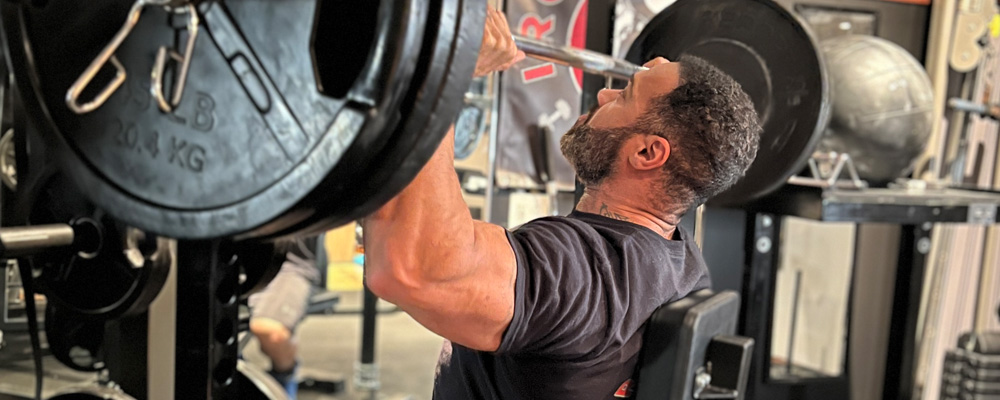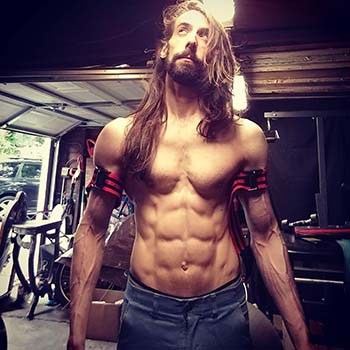Blog
Overhead Pressing
How to Choose Between Standing and Seated Overhead Press
“Strong shoulders are healthy shoulders.” Mark Rippetoe spoke those words. Love him, like him, or leave him alone, Rip has a point.
As is widely known but less widely acted upon, endless amounts of bench pressing can lead to wear and tear on the shoulder joint, resulting in shoulders that hurt all the time. Upper back training can help rectify this sad state of affairs, while proper overhead pressing is also essential, since the shoulder blades need to be trained in every direction they move in (and that’s a lot of directions) in order to be happy. And by “happy,” I mean as pain-free and useful as possible, as opposed to painful and barely functioning.

Let’s not overlook the obvious showroom appeal of what are sometimes referred to as “boulder shoulders.” In the age of the Traplords, big shoulders are now the new big pecs. Well, depends who you ask, I guess, but the fact remains that the outer contour of the deltoids is visible from the front, meaning that the bigger your delts are, the larger and more imposing your appearance can be.
And, I mean, you want to look big, right?
Oh, you don’t? Oh, okay.
Wait, you were just kidding? You DO want to look big? Oh! Sick! Read on!
Benefits of overhead training
Of course, the muscles that receive the most training volume generally grow the fastest. We all want our muscles to grow as quickly as possible, but working one muscle group too much and the others not enough can lead to muscular imbalances. And the hazards are not just aesthetic. I wish they were. Muscular imbalances are a recipe for injuries down the line.
For example, poor overhead mobility is often tied to tightness in the lats. If you have tight lats and you’re bench pressing 4 times a week, what do you think might happen? You’re lying there, benching, minding your own business, when all of a sudden, your lats refuse to stay down and back while the bar is near your chest. Your elbows flare out like the doors on a Dodge Hellcat. Suddenly, your rotator cuff and its associated connective tissues roll into the shoulder joint like documents into a paper shredder. And six months of rehab later, the only remaining evidence that you ever benched four times a week is a surgery scar. Ouch. Enter ‘overhead training’ to fend off this and any number of other scenarios.
A common question is “Will the overhead press increase my bench?” This is one of those things where a straight-up “yes” would be great. But it’s not that simple. Ask ten different fitness authorities and you’ll get different answers.
Suffice it to say that overhead pressing “increases” the bench press at least in the sense that it prevents injuries which would have the effect of reducing it. Plus, it strengthens the triceps, which can help improve the bench. And maybe, for some people, it does seem to increase it. So, let’s move on.
Methods of Overhead Pressing
There are two ways to overhead press: standing and sitting. Both are compound movements. The standing overhead press involves core strength and stability, while seated can help focus on overall mobility and shoulder health.
The benefits of one over the other mainly come down to what you’re interested in. Full-body strength? Building core strength and stability? Maybe you have an injury that prevents you from overhead pressing while standing, or you train in a home gym with a low ceiling.
How Do I Choose?
The main point to remember is: other than basing your decision on your goals, whether you press standing or seated doesn’t really matter. Getting your overhead work in is the most important thing. Let’s go over the benefits of each in a little more detail to help you decide.
The standing overhead press has the distinction of being more of a full-body exercise. This means that it involves more muscles and requires more balance.
The most obvious benefit of seated overhead pressing with a near-vertical seatback such as the Seated Press Pad is stability. Plus, keeping your core and glutes clenched both raises the tailbone off the bench itself and helps prevent prevent excessive arching or rounding of the lower back. It’s basically impossible to lean back while lifting, making for a potentially stricter movement that stays focused on the deltoids and away from the upper chest.
It’s worth noting that the increased full-body tightness that both of these actions help you achieve will also help make you stronger on the lift.
Main OHP Movements
All of these can be done seated or standing unless otherwise noted.
Strict Press
This is your basic barbell overhead press with about a shoulder-width grip and starting at upper chest height. The “strict” refers to avoiding any bouncing, excessive leaning, or shortening of the range of motion.
Close-Grip Press
The close-grip version uses a grip that narrower than shoulder width. It builds more of the triceps and upper back and could be useful for attaining bench press carryover.
Wide-Grip Press
This builds more of the side deltoid, but be careful; the increased elbow flare could pose a shoulder injury hazard. Ideal for chin-height pin presses (see below).
Dumbbell Overhead Press (aka Military)
Because the lifter’s head does not impede the path of the weights with the dumbbell version, it is very versatile and safe, and ideal for seated pressing for this reason.
Dumbbell Neutral-Grip Press
The neutral grip dumbbell press pulls the elbows more in front of the lifter, recruiting more front delts, triceps, and upper chest.
Dumbbell Unilateral Overhead Press
Another rare variation, this is a great core-builder because you have to try to keep from leaning over towards the unweighted side like the proverbial “I’m a little teapot, short and stout.”
Dumbbell Arnold Press/Scott Press
The Arnold Press is a dumbbell overhead variation that works the front and lateral heads of the deltoids while being very forgiving on the shoulders. The similar Scott Press does this too, while also including the rear deltoid to boot.
Barbell Overhead Pin Press
This variation requires a power rack and allows you to build strength at various potential sticking points throughout the range of motion, such as the neck, chin, forehead, or above.
Behind the Neck (BTN) Press
The BTN OHP remains a controversial lift. Those with touchy shoulders should avoid it. If you can perform it pain-free, it is a potent side and rear delt builder, plus I believe it strengthens the position that the upper back has to maintain during the low-bar squat. So that’s cool too. For extra safety, doing it seated at a Smith machine such as the IM2000 ensures a consistent bar path.
Z-Press
The Z-Press involves sitting on the floor with your legs in front of you while pressing. What does this accomplish? No lean, no arch, and no cheating of any kind. It’s named after Žydrūnas Savickas, 4-time world’s strongest man. So I’m pretty sure it’s legit.
So Which One Is Best, Seated or Standing?
I could be dogmatic, and say one is better than the other, or I could be realistic and say: The best one is whichever gets you pushing a weight over head! So, warm up those soon-to-be boulder shoulders and reach for the sky!
About the author
Mark Ludas CPT is a NASM-certified personal trainer with a decade of experience in the fitness industry. After an asthmatic childhood, Mark discovered his natural aptitude for fitness in his late twenties. At age 36, he accomplished a 300+ pound conventional deadlift and 280+ high-bar squat as a 6’5” 170-pound ectomorph on a fully vegan diet, all after just one year of proper self-programming. Mark is the founder of Resistance Quest Fitness, established in 2016, and the creator of the Paralinear Method of strength training. Additionally, he is a writer, actor, model, and musician. Find him on Instagram, Facebook, Youtube, and at www.resistancequest.com.

